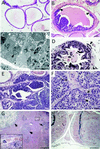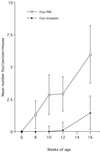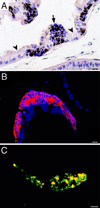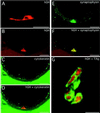A transgenic mouse model of metastatic prostate cancer originating from neuroendocrine cells
- PMID: 9860977
- PMCID: PMC28051
- DOI: 10.1073/pnas.95.26.15382
A transgenic mouse model of metastatic prostate cancer originating from neuroendocrine cells
Abstract
A transgenic mouse model of metastatic prostate cancer has been developed that is 100% penetrant in multiple pedigrees. Nucleotides -6500 to +34 of the mouse cryptdin-2 gene were used to direct expression of simian virus 40 T antigen to a subset of neuroendocrine cells in all lobes of the FVB/N mouse prostate. Transgene expression is initiated between 7 and 8 weeks of age and leads to development of prostatic intraepithelial neoplasia within a week. Prostatic intraepithelial neoplasia progresses rapidly to local invasion. Metastases to lymph nodes, liver, lung, and bone are common by 6 months. Tumorigenesis is not dependent on androgens. This model indicates that the neuroendocrine cell lineage of the prostate is exquisitely sensitive to transformation and provides insights about the significance of neuroendocrine differentiation in human prostate cancer.
Figures





Similar articles
-
Development, progression, and androgen-dependence of prostate tumors in probasin-large T antigen transgenic mice: a model for prostate cancer.Lab Invest. 1998 Mar;78(3):319-33. Lab Invest. 1998. Corrected and republished in: Lab Invest. 1998 Jun;78(6):i-xv. PMID: 9520945 Corrected and republished.
-
Development, progression, and androgen-dependence of prostate tumors in probasin-large T antigen transgenic mice: a model for prostate cancer.Lab Invest. 1998 Jun;78(6):i-xv. Lab Invest. 1998. PMID: 9645768
-
A probasin-large T antigen transgenic mouse line develops prostate adenocarcinoma and neuroendocrine carcinoma with metastatic potential.Cancer Res. 2001 Mar 1;61(5):2239-49. Cancer Res. 2001. PMID: 11280793
-
Neuroendocrine differentiation in prostatic carcinoma: an update.Prostate Suppl. 1998;8:74-9. Prostate Suppl. 1998. PMID: 9690666 Review.
-
Genetically modified mice and their use in developing therapeutic strategies for prostate cancer.J Urol. 2004 Jul;172(1):12-9. doi: 10.1097/01.ju.0000132122.93436.aa. J Urol. 2004. PMID: 15201729 Review.
Cited by
-
Matrix metalloproteinases contribute distinct roles in neuroendocrine prostate carcinogenesis, metastasis, and angiogenesis progression.Cancer Res. 2010 Mar 15;70(6):2224-34. doi: 10.1158/0008-5472.CAN-09-3515. Epub 2010 Mar 9. Cancer Res. 2010. PMID: 20215503 Free PMC article.
-
Simian virus 40 transformation, malignant mesothelioma and brain tumors.Expert Rev Respir Med. 2011 Oct;5(5):683-97. doi: 10.1586/ers.11.51. Expert Rev Respir Med. 2011. PMID: 21955238 Free PMC article. Review.
-
Prostatic intraepithelial neoplasia in genetically engineered mice.Am J Pathol. 2002 Aug;161(2):727-35. doi: 10.1016/S0002-9440(10)64228-9. Am J Pathol. 2002. PMID: 12163397 Free PMC article.
-
A fluorescence-coupled assay for gamma aminobutyric acid (GABA) reveals metabolic stress-induced modulation of GABA content in neuroendocrine cancer.PLoS One. 2014 Feb 13;9(2):e88667. doi: 10.1371/journal.pone.0088667. eCollection 2014. PLoS One. 2014. PMID: 24551133 Free PMC article.
-
Rebuilding cancer metastasis in the mouse.Mol Oncol. 2013 Apr;7(2):283-96. doi: 10.1016/j.molonc.2013.02.009. Epub 2013 Feb 20. Mol Oncol. 2013. PMID: 23474222 Free PMC article. Review.
References
-
- Parker S L, Tong T, Bolden S, Wingo P A. Ca Cancer J Clin. 1996;46:5–27. - PubMed
-
- Schwartz K L, Severson R K, Gurney J G, Montie J E. Cancer. 1996;78:1260–1266. - PubMed
-
- Bonkhoff H, Remberger K. Prostate. 1996;28:98–106. - PubMed
-
- Bonkhoff H, Stein U, Remberger K. Hum Pathol. 1994;25:42–46. - PubMed
-
- Bonkhoff H, Stein U, Remberger K. Prostate. 1994;24:114–118. - PubMed
Publication types
MeSH terms
Substances
Grants and funding
LinkOut - more resources
Full Text Sources
Other Literature Sources
Medical
Molecular Biology Databases

